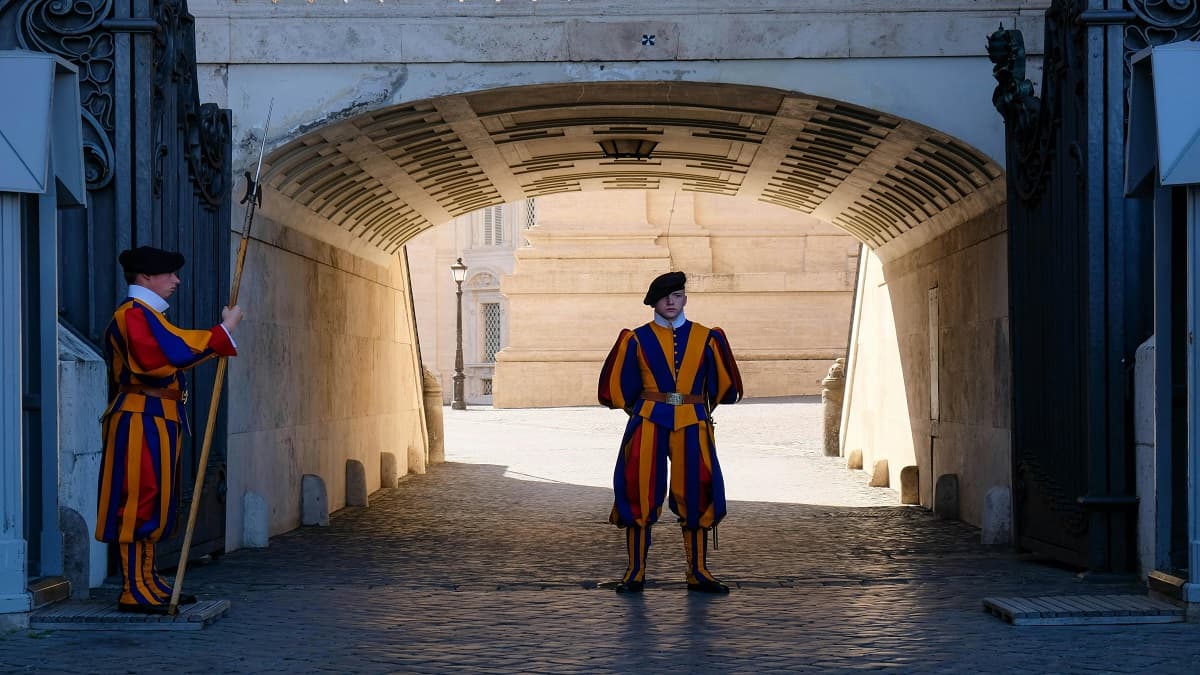Today, when we talk about the Swiss Guard, we immediately think of members of the Pontifical Swiss Guard—those young soldiers dressed in Renaissance uniform with which tourists love to have their photo taken at St. Peter’s. But, between the 15th and 19th century the Swiss Guards referred to all the young Swiss mercenaries who served as guards at the most important European courts.

CREATION OF THE PONTIFICAL SWISS GUARD
The Pontifical Swiss Guard was created by Pope Julius II on the 22nd of January 1506. That year, 150 Swiss soldiers, led by Captain Kaspar von Silenen, arrived in Rome. They entered through the Porta del Popolo and reached St. Peter's, where the Pope then blessed them from the Benediction Loggia. Since then, for more than 500 years, the Swiss Guard has been responsible for the protection and safety of the Pope.
THE SACK OF ROME
A few years later, the Guards faced one of the toughest tests of their existence. On May 6, 1527, Emperor Charles V’s troops, composed mainly of Spanish soldiers and German mercenaries, invaded and plundered Rome. That day, 147 Swiss Guards lost their lives, ensuring Pope Clement VII’s safe escape to Castel Sant’Angelo.
OATH
It is for this reason that the recruits take their oath of loyalty on May 6th, the anniversary of the sack of Rome of 1527. The ceremony is held in the historic St. Damaso courtyard, in the Vatican. The oath is read in the 4 official languages of Switzerland: French, Italian, Ladin, and German. Then, one by one, each recruit confirms the oath in his own language, holding the guard’s standard in his left hand and raising up his right hand with three fingers open, representing the holy Trinity.
HOW TO BECOME A SWISS GUARD
To become a Swiss Guard, applicants must fulfill several requirements. Firstly, they must be of Swiss nationality and under 30 years of age. Admission is only open to unmarried men, although guards can marry after their 25th birthday as long as they’ve already served at least 3 years, commit themselves to serving another 3 years, and are at least at the rank of Corporal. Naturally, applicants must be practicing Catholics, be of irreproachable character, and pass a thorough medical exam and psychological test. Candidates must have also served in the Swiss army and have either a professional diploma or a high school degree. Finally, applicants must be at least 174 cm tall. For more information, visit the Apostolic Palace.
THE WORLD’S SMALLEST ARMY
The Pontifical Swiss army is the world’s smallest army, as is reflected in the title of the 2015 documentary about the soldiers entrusted with the Pope’s protection. The army is made up of 110 men: 6 officials, 26 sub-officers, and 78 guards or halberdiers. The commander of the Guard is called the Oberst or Colonel. One of the other officials is the Kaplan, or military chaplain, who prepares the recruits for their oath and provides spiritual guidance for the entire corps. He is considered of the same rank as a Lieutenant Colonel.
The main mission of the Pontifical Swiss Guard is to guarantee the safety of the Supreme Pontiff in his residence, during liturgical celebrations, and on his trips. When the Apostolic See is vacant, the Guards protect the college of Cardinals. Since 1929, they have also guarded the entrance to the Vatican.
Before Pope Francis was elected, every Pope had lived in the Apostolic Palace: the Gendarmerie of the Vatican City State dealt with security outside the palace, while the Swiss Guards were responsible for security within. Following Pope Francis’ decision to live in the Casa Santa Maria, these two corps joined forces to create a mixed team in order to protect the Holy Father.
THEIR UNIFORM: MICHELANGELO OR RAPHAEL?
When one thinks of the Swiss Guards, the first thing that comes to mind is their red, yellow, and blue-striped, Renaissance-inspired uniform. The red and blue were the colors of the Della Rovere family, to which Pope Julius belonged, while red represented the color of the Medici family, of which Pope Clement VII was a member.
For a very long time, a rumor went around that the uniform was the work of either Michelangelo or Raphael. In reality, Michelangelo had absolutely nothing to do with the creation of the uniform, and Raphael, at most, provided the inspiration for the uniform’s puffed sleeves.
In spite of these beliefs, the “Gala uniform” as we know it today was only introduced at the beginning of the 20th century by Commander Jules Repond. Before creating it, Repond meticulously studied the various representations of the Swiss Guard throughout the centuries since the Renaissance.
The Uniform is Usually Worn with a Blue Basque Cap
At Christmas, Easter, and the swearing-in ceremonies, 17th-century armor is added to the Gala uniform, which includes a silver helmet with an ostrich feather.
Another uniform, the co-called “Exerzieruniform” (exercise uniform), is used for training, during night duties, and at the entrance to St. Anne’s.

Vox City, The Vox Group's Dedicated Business-To-Consumer Arm For The Past Five Years, Is Staffed By Veteran Travel Industry Experts With A Combined 21 Years Of Expertise In The Tourism Industry. Let's Explore The Beauty Of Travel In Your Own Way At Your Own Pace.
Vox City International 63 Holly Walk | CV32 4JG Leamington Spa
2025 Vox City, All rights reserved.





